Estonia and Helsinki 2008
One of the original aims of my previous trip to Estonia was to visit Narva, in the north-east of the country, where 96% of the population are Russian, but I did not get there. Until the collapse of the Soviet Union in 1991 there had been freedom of movement between Russia and Estonia for a very long time, and many Russians had settled in Estonia, to work in the heavy industry in the Narva area.
As the trip to Narva and back from Tallinn would only take two days, it seemed a good opportunity to spend an extra day in Helsinki, using one of the fast ferries across the Baltic. The plan was to fly from Gatwick to Tallinn and stay two nights in a hotel at the port, and then hire a car and drive to Narva for one night.
The flight was with Estonian Air, as before, and arrived early afternoon. There was a free bus from the airport to the harbour, with standing room only by the time I got on. It appeared to be driven by someone training to be Estonia's first Formula 1 driver, and after 6 stops I was quite happy to get off. The Reval Inn was about 100 yards from the harbour entrance, and after having a snack in a café opposite and checking the ferry times at the Nordic Jet Line office I went for a look round the town.
On the previous trip I had seen the Old Town, but not the modern one, and this time I was able to do both. The modern town does not have a great deal of character, but good shops and a branch of the famous Stockmann store, from Finland. It was very busy on a Thursday afternoon. On the way back I noticed a strange building next to the hotel that was apparently a concert hall, but looked as if it had been designed by Albert Speer (Hitler's architect), although that is unlikely.
The next morning I bought a ticket for the 10.15 Nordic Jet to Helsinki, to return at 19.30. The vessel itself was quite 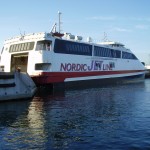 impressive with an equally impressive name, a 60m long car-carrying catamaran called a Kvaerner Fjellstrand 60m JumboCat. The crossing time is about 1¾ hours, and they only operate from May to November because they cannot cope with the ice floating around in the Baltic in the winter. For foot passengers the cheapest fare is about £32 return.
impressive with an equally impressive name, a 60m long car-carrying catamaran called a Kvaerner Fjellstrand 60m JumboCat. The crossing time is about 1¾ hours, and they only operate from May to November because they cannot cope with the ice floating around in the Baltic in the winter. For foot passengers the cheapest fare is about £32 return.
The harbour is actually very busy, because it is the main crossing point between the Baltic States and Scandinavia. There are several fast ferries and numerous conventional ones. The most frequent services are to Helsinki, but there are others to St.Petersburg, Kiel and Stockholm.
The weather in Helsinki was very bright, but surprisingly cool for late June, only about 13 - 15ºC. For a capital city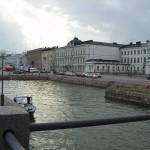 Helsinki is very compact, and you can see all the main sights on foot in a few hours. The harbour area has a line of traditional naval-style buildings along side the quay, and there are many other fine public buildings in the central area, including a huge cathedral. I had a snack in the vast Stockmann store, which was being renovated and most of it was covered with plastic. The railway station was said to be worth a visit, but there were some very peculiar-looking people around there, some like characters from a Nordic saga and others dressed like 19th century explorers. I got the impression that they were not in fancy dress, but just went around like that.
Helsinki is very compact, and you can see all the main sights on foot in a few hours. The harbour area has a line of traditional naval-style buildings along side the quay, and there are many other fine public buildings in the central area, including a huge cathedral. I had a snack in the vast Stockmann store, which was being renovated and most of it was covered with plastic. The railway station was said to be worth a visit, but there were some very peculiar-looking people around there, some like characters from a Nordic saga and others dressed like 19th century explorers. I got the impression that they were not in fancy dress, but just went around like that.
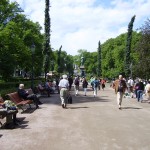 There were a lot of classic cars about, and the city has a motor museum, which I visited. It is in a side street some distance from the centre, and the door was locked when I arrived, but a man saw me trying to get in and unlocked the door. It is a very small museum, with only a few cars, but what is claimed to be the largest collection of models of Mercedes Benz vehicles in the world. There are 5000, so that is probably true.
There were a lot of classic cars about, and the city has a motor museum, which I visited. It is in a side street some distance from the centre, and the door was locked when I arrived, but a man saw me trying to get in and unlocked the door. It is a very small museum, with only a few cars, but what is claimed to be the largest collection of models of Mercedes Benz vehicles in the world. There are 5000, so that is probably true.
In Helsinki everyone can speak English, but signs are not necessarily in English. In one café I could not tell which toilets were which, so I asked some ladies at a nearby table. One of them got up and tapped on the letters of the Finnish word on the door and read them out as if I was a complete idiot not to know that it meant gents. She then sat down and they all had a laugh at my expense.
Most things in Helsinki are much dearer than in England, sometimes by as much as 50%, and it certainly not a place to  go for a shopping spree. I did manage to find an English paperback for €1 in a second hand bookshop.
go for a shopping spree. I did manage to find an English paperback for €1 in a second hand bookshop.
On a bright day at the end of June I think I saw the city at its best, and I can imagine that in the middle of winter, with the short days, long nights and low temperatures it could be quite depressing.
The next morning I got up early and caught the bus to the airport, where I was picking up the car to go to Narva. It was an Opel Corsa from Budget Car Rental, and I was on the road to Narva by 10.00am. From Tallinn to Narva is about 150 miles. It was a straightforward but unpleasant drive, because most of time I was facing into the sun and the Corsa has appalling reflections of the dashboard in the windscreen, making it difficult to see 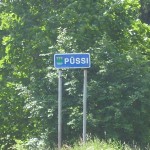 anything in shadow.
anything in shadow.
My interest in Estonia was sparked by a book called FIREWALL by Andy McNab, in which much of the action takes place in the Narva area, including a village called Pussi. Needless to say, this gave rise to a comment from McNab, but when I went to look at Pussi there was nothing much to see.
A few miles before Narva I turned off towards the coast and went up to a seaside resort called Narva-Jõesuu, which is quite old fashioned and undeveloped. It is really like a village, very heavily wooded and with little road access to the beach. On the back roads there was plenty of parking space, but nowhere that I would consider to be safe, and in the areas where it did appear to be safe it was impossible to find a space. There was what looked like a car park with a lady attendant next to a hotel, and when I pulled in she came over to me and I asked her if she spoke English. She had a very broad face, with the widest mouth I have ever seen, displaying about 40 teeth. It seemed that she did not speak English, and when I asked if I could park there she shook her head, and closed her mouth so that her dark red lips formed a thin line about 5in long, as if they were zipped together. It was clear that they were not going to be unzipped again in my presence, so I drove away. That was the most memorable face of 2008.
About ¼ mile further along the road there was another car park with a man in charge, but I got the same sort of reaction, and gave up. I did manage to briefly walk through to the beach, and it appeared to be quite good, with a wide 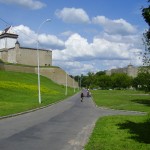 stretch of sand and few people.
stretch of sand and few people.
The road from there into Narva runs alongside the river Narva, with Russia on the opposite bank, and on the approach to the town the road surface disappeared completely for several hundred yards. There was work in progress, but it looked as if it had been like that for a very long time.
The King Hotel, which I had pre-booked on the internet, was easy to find, and perfectly satisfactory. It was an old building, furnished in the traditional style, with a guarded car park at the back. After getting sorted I went for a walk round the town. When Estonia became independent in 1991 the Russia residents were cut off from their homeland and this has led to a lot of problems. 96% of the people in Narva are Russian, and that is the dominant language in the area. Whereas in Tallinn few East European vehicles are to be seen, Narva is still Lada 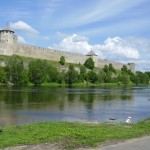 country.
country.
There are few border crossings from Estonia into Russia, and the bridge at Narva is the most important one. The scene from the river bank above the bridge is quite dramatic, with castles high up on both sides of the river, directly facing one another. The bridge down below is straight out of a Cold War movie, with high wire fences on both sides and a gatehouse with barrier on the Russian side. It was easy to imagine spies being exchanged on a foggy night in the winter.
In fact, of course, Narva and Ivangorod, the town on the Russian side, were effectively one town for 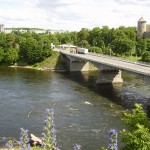 many years until 1991, with freedom of movement between them. The wire fences now extend right back into Narva, with massive customs buildings and holding areas for lorries, with many more waiting along the main road into the town from Tallinn.
many years until 1991, with freedom of movement between them. The wire fences now extend right back into Narva, with massive customs buildings and holding areas for lorries, with many more waiting along the main road into the town from Tallinn.
Much though I would have liked to have crossed over that bridge, it was not possible, because I did not have a Russian visa. For a long time I sat watching the events down below, and it was very much in slow motion. Vehicles were allowed into Ivangorod at the rate of two every half hour, and periodically people would go through on foot. The land border crossings into Russia are notorious for long waiting times, especially for vehicles, and this one is certainly no exception. As far as I could see, there was nothing to stop anyone from swimming across, if they were competent to  do so.
do so.
After an evening meal in the hotel I went for another walk, and discovered the wonderful old town hall, one of the few pre-war buildings left in Narva. The next morning I set off for Tallinn, but diverted to look at Kohtla-Jarva, a former industrial town which has fallen on hard times. In a strange sort of way it was reminiscent of a wild west town, with buildings spaced out along both sides of the wide main street.
The journey back to Tallinn and the flight were uneventful, and I felt that I seen all I wanted to see of Estonia.
May 30th, 2010 - 20:11
My cousin recommended this blog and she was totally right keep up the fantastic work!
May 30th, 2010 - 21:23
Thank you, I am glad you like it. Russian story coming up soon!
Regards
Bevis
September 16th, 2010 - 13:28
I have to say that I like this website. I thought I would drop a comment and say what a sweet job you’ve done. I wish other people would put so much time into their site. Keep the posts coming.
September 16th, 2010 - 18:49
Thank you. I am glad you like it.
Regards
Bevis